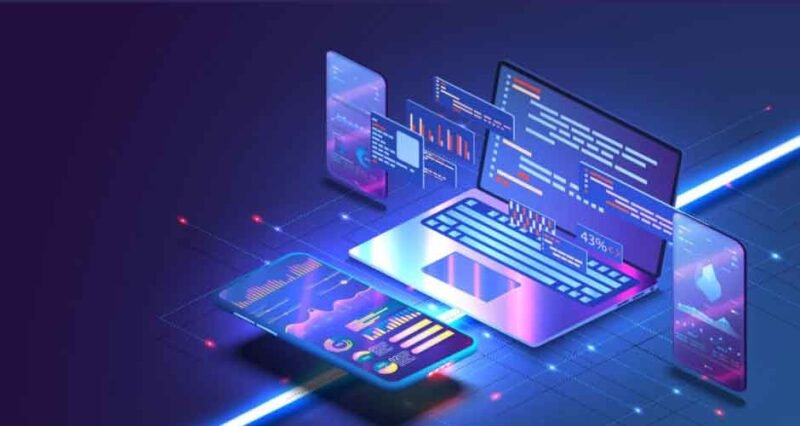
In today’s digital age, application development is pivotal in shaping how businesses operate and interact with customers. From mobile apps to web applications, the demand for innovative and user-friendly software solutions continues to grow exponentially. Understanding the trends and steps involved in application development is crucial for businesses looking to stay ahead in this dynamic landscape.
The application development process entails the creation of software applications that operate on diverse platforms, including mobile devices, desktops, and the web. This multifaceted process entails crucial stages such as meticulous planning, comprehensive design, rigorous development, meticulous testing, and seamless deployment. Application development has evolved significantly over time, primarily influenced by technological progress and the dynamic shift in user expectations. Engage with the professionals at IT Support Portland to take the leverage of latest application development trends.
In this article, we will explore what is application development, application development trends and steps of application development.
What is Application Development?
Application development refers to creating software applications that run on various devices and platforms, such as computers, smartphones, and tablets. It involves designing, coding, testing, and deploying applications to meet specific user needs or business requirements.
Application developers use programming languages and development frameworks to build these applications. They also consider factors such as user experience, security, scalability, and performance during development. Application development plays a crucial role in modern technology-driven industries by enabling businesses to create innovative solutions and improve efficiency through customized software applications.
Application Development Trends
-
Low-Code and No-Code Development
Low-code and no-code development is an emerging trend in application development that allows individuals with little to no coding experience to create software applications. This approach involves using visual interfaces and drag-and-drop tools to build applications, eliminating the need for manual coding.
Low-code and no-code platforms provide a faster and more accessible way to develop applications, enabling businesses to streamline their development processes and reduce reliance on technical expertise. These platforms also promote collaboration between business users and IT teams, as they can create custom applications that meet specific business needs. With the increasing demand for digital transformation, low-code and no-code development are expected to continue gaining popularity in the coming years.
-
Mobile IoT apps
Mobile IoT apps are becoming increasingly popular in the world of application development. With the rise of Internet of Things (IoT) technology, developers can now create innovative and interconnected applications that can be accessed and controlled through mobile devices. These apps allow users to monitor and manage various aspects of their daily lives, such as home security systems, smart appliances, and wearable devices.
Integrating mobile devices with IoT technology has opened up new possibilities for businesses and individuals, providing convenience, efficiency, and enhanced functionality. As the demand for IoT technology continues to grow, we expect to see even more mobile IoT app development advancements.
-
AI and Machine Learning Integration
AI and machine learning integration is a critical trend in application development. With advancements in technology, AI and machine learning algorithms are becoming increasingly sophisticated, allowing for the development of intelligent applications that can learn and adapt over time. This integration has the potential to revolutionize various industries by enabling applications to automate tasks, make data-driven decisions, and improve overall efficiency.
By leveraging AI and machine learning capabilities, businesses can gain valuable insights from large datasets, enhance customer experiences through personalized recommendations, and streamline operations. As this trend continues to evolve, we can expect to see more innovative applications that harness the power of AI and machine learning to drive growth and innovation.
-
Progressive Web Apps (PWAs)
Progressive Web Apps (PWAs) are one of the latest trends in application development. PWAs combine the best features of web and mobile applications to provide a seamless user experience. These apps can be accessed through a web browser, eliminating users needing to download and install them on their devices.
PWAs are designed to be responsive, fast, and reliable, offering an app-like experience without the hassle of traditional app installations. They also can work offline or with limited connectivity, making them particularly convenient for users in areas with unreliable internet access. With their cross-platform compatibility and improved performance, PWAs are becoming increasingly popular among developers and businesses looking to deliver high-quality applications to their users.
Application Development Steps
-
Define the Requirements
Defining the requirements is a crucial step in the application development process. It involves gathering and documenting the application’s specific functionalities, features, and performance expectations. This step helps to establish a clear understanding between the development team and stakeholders about what needs to be achieved with the application.
It also ensures that all parties involved have a shared vision and can make informed decisions throughout development. Defining the requirements typically involves conducting interviews, surveys, and workshops with stakeholders to gather their input and identify their needs and preferences. This information is then documented in a requirements specification document, which serves as a blueprint for the development team.
-
Design the Application
Designing the application is an integral and pivotal step in the application development process. During this phase, the overall layout and functionality of the application are planned and implemented. It involves creating wireframes or prototypes that depict the application’s user interface and navigation flow. The design should focus on providing a seamless user experience with clear and intuitive navigation.
It is essential to consider usability, accessibility, and responsiveness across different devices and screen sizes. Collaborating with designers and developers ensures that the design aligns with the project requirements and objectives. By thoroughly designing the application, you set a solid foundation for its development and enhance its chances of success in meeting user needs and expectations.
-
Develop the Application
Once you have finalized the design and gathered all the necessary resources, it is time to develop the application. This step involves coding and programming the various functionalities and features of the application. Following best practices and adhering to coding standards ensures a smooth development process. The development phase may involve multiple iterations and testing to identify and fix any bugs or issues.
Additionally, it is crucial to regularly communicate with the development team and stakeholders to ensure that the application aligns with their requirements and expectations. Once the development is complete, thorough testing should be conducted before moving on to the next phase of deployment and launch.
-
Test the Application
Testing the application is an essential steps of app development process. It allows developers to identify and fix any bugs or errors before the application is released to users. The testing phase involves conducting various tests, such as functional testing, performance testing, and usability testing, to ensure that the application meets the desired standards of functionality, speed, and user experience.
Testers verify that the application works seamlessly on different devices and operating systems. By thoroughly testing the application, developers can ensure it is reliable, stable, and ready for user deployment.
Final Words
Understanding the ever-evolving landscape of application development requires an awareness of the dynamic nature of emerging trends and evolving methodologies. By remaining attentive to these trends and embracing the essential steps in the development process, businesses and developers can effectively navigate the complexities of modern app creation. The application development journey is marked by innovation, collaboration, and adaptability, from the ascent of AI and machine learning to the pivotal role of user-centric design and agile development practices. Maintaining agility, continually acquiring knowledge, and embracing new technologies to craft applications that meet and surpass user expectations in an ever-changing digital world is imperative. To get more insights, contact the Managed IT Services Nashville experts.

